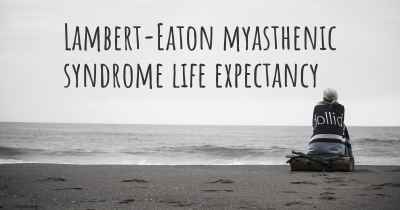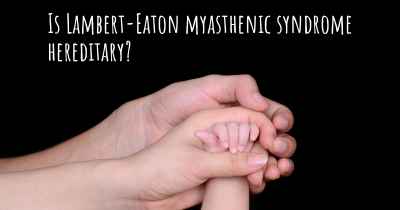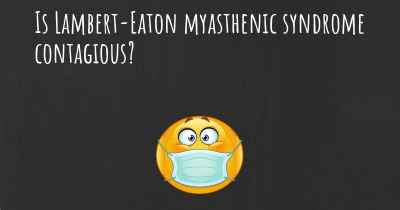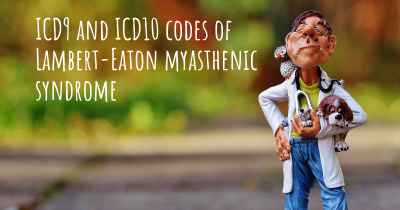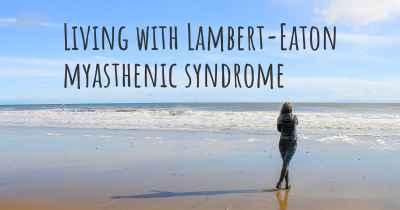What is the history of Lambert-Eaton myasthenic syndrome?
When was Lambert-Eaton myasthenic syndrome discovered? What is the story of this discovery? Was it coincidence or not?

Lambert-Eaton myasthenic syndrome (LEMS) is a rare autoimmune disorder that affects the neuromuscular junction, causing muscle weakness and fatigue. The history of LEMS dates back to the mid-20th century when it was first recognized and characterized.
Discovery and Early Observations:
The syndrome was first described by Dr. Edward Lambert and Dr. Lee Eaton in 1956. They reported a series of patients who presented with muscle weakness, autonomic dysfunction, and small-cell lung cancer. These patients exhibited a unique pattern of muscle weakness that was distinct from other neuromuscular disorders.
Autoimmune Connection:
In the 1970s, researchers began to investigate the underlying cause of LEMS. It was discovered that LEMS is an autoimmune disorder, meaning that the body's immune system mistakenly attacks its own tissues. In the case of LEMS, the immune system targets the voltage-gated calcium channels (VGCCs) in the neuromuscular junction.
Role of Voltage-Gated Calcium Channels:
Voltage-gated calcium channels play a crucial role in the release of neurotransmitters, specifically acetylcholine, which is essential for proper muscle contraction. In LEMS, autoantibodies are produced that target and inhibit these VGCCs, leading to reduced release of acetylcholine and subsequent muscle weakness.
Association with Small-Cell Lung Cancer:
One of the significant observations made early on was the strong association between LEMS and small-cell lung cancer (SCLC). It was found that a majority of LEMS patients also had an underlying SCLC. This led to the hypothesis that the tumor cells were triggering an immune response, resulting in the development of LEMS.
Identification of Antibodies:
In the 1980s, researchers identified the specific antibodies responsible for LEMS. These antibodies, known as P/Q-type voltage-gated calcium channel antibodies, were found in the serum of LEMS patients. The presence of these antibodies became a crucial diagnostic marker for LEMS.
Advancements in Treatment:
Over the years, significant advancements have been made in the treatment of LEMS. In the past, the mainstay of treatment was the use of 3,4-diaminopyridine (DAP), a medication that enhances the release of acetylcholine. However, DAP had limited efficacy and significant side effects.
In recent years, the introduction of immunomodulatory therapies has revolutionized the management of LEMS. These therapies aim to suppress the immune system and reduce the production of autoantibodies. One such treatment is intravenous immunoglobulin (IVIG), which provides temporary relief of symptoms by neutralizing the antibodies.
Connection to Other Autoimmune Disorders:
LEMS is also associated with other autoimmune disorders, such as thyroid disease, rheumatoid arthritis, and vitiligo. The exact mechanisms underlying these associations are not fully understood, but it is believed that shared genetic and immunological factors contribute to their co-occurrence.
Improved Prognosis:
With advancements in diagnosis and treatment, the prognosis for LEMS has significantly improved. Early detection of LEMS, especially in the absence of an underlying malignancy, allows for prompt initiation of immunomodulatory therapies, leading to better outcomes and improved quality of life for patients.
Ongoing Research:
Despite the progress made in understanding LEMS, there is still ongoing research to further elucidate the underlying mechanisms and develop more targeted therapies. Researchers are exploring novel treatment options, including the use of immunosuppressive drugs and targeted immunotherapies.
In conclusion, Lambert-Eaton myasthenic syndrome is a rare autoimmune disorder that was first described in the 1950s. It is characterized by muscle weakness, autonomic dysfunction, and an association with small-cell lung cancer. The discovery of autoantibodies targeting voltage-gated calcium channels paved the way for improved diagnosis and treatment. Advancements in immunomodulatory therapies have significantly improved the prognosis for LEMS patients, and ongoing research continues to expand our understanding of this complex disorder.
